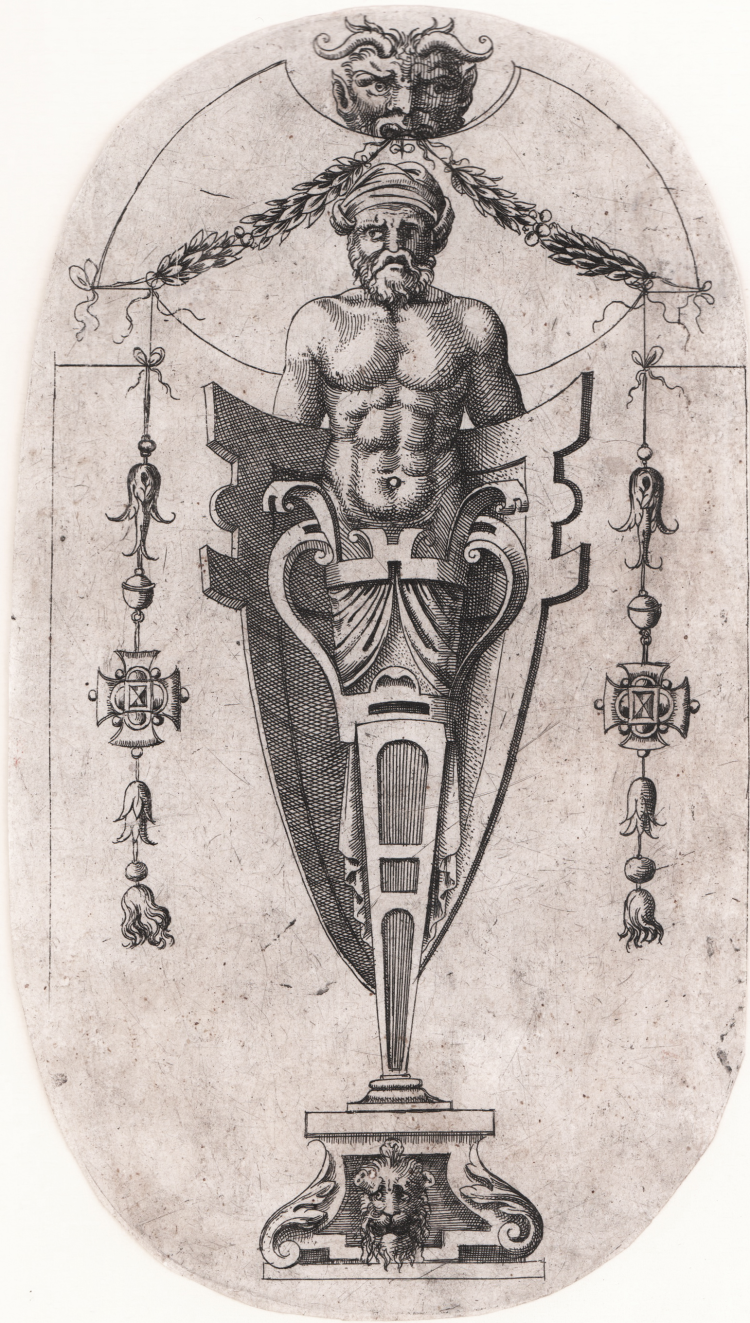




| Reference: | S46041 |
| Author | Jean MIGNON |
| Year: | 1544 ca. |
| Measures: | 130 x 230 mm |



| Reference: | S46041 |
| Author | Jean MIGNON |
| Year: | 1544 ca. |
| Measures: | 130 x 230 mm |
Niche adorned with bearded man, placed under a horned mask, with two hanging garlands on each side; within oval.
Etching, ca. 1543/45, lacking signature and editorial indications. Example in the first state of two, before the number.
According to Zerner's chronology of Jean Mignon's etching work, which covers the years 1543-1546, the series of twenty niches (fr. Termes) would have been made around 1544, i.e., shortly before the executed suite devoted to the History of Troy from drawings by Luca Penni.
There is no doubt that the twenty figure-adorned niches belong to a series conceived as such, as evidenced by the deliberate consistency of the subjects, the uniform choice of copper oval, the paper format, and the technique. Over the course of the series, Mignon produced an odd compilation of motifs borrowed from a variety of sources, though not always easily identifiable. Following Zerner, we note the similarity of the Satyr with the twisted legs to one of the framing figures of the Marco Curzio engraved from Luca Penni's drawing. The Woman carrying a basket on her head and the Hercules armed with a club, on the other hand, derive from subjects by Agostino Veneziano: these two figures appear in the Hermae series engraved by Marcantonio's pupil in 1536. In this case, Mignon very faithfully quotes his Roman model, while replacing Augustine's striated backgrounds with plant motifs, the inventiveness of which is the hallmark of the series produced at Fontainebleau. Woman in Profile is, however, directly related to a drawing by Polidoro da Caravaggio kept in the Cabinet des Dessins of the Louvre.
Peter Fuhring (cf. La Gravure Francaise à la Renaissance à la Bibliothéque nationale de France, 1994, pp. 153-168) has noted how engravers working in France in the mid-sixteenth century exploited the language of ornament, whether to provide models for goldsmiths and sculptors or simply for the sake of an exuberant and ornate form. Mignon's Termes testify to this love: the artist combines different types of ornamentation, both derived from ancient tradition (such as caryatids, grotesques, masks, and festoons) and from Renaissance forms of decoration that favored garlands of fruit and flowers, animals, trophies, jewelry, and musical instruments, or even architectural elements (a bridge or the framework of a niche) all of which serve as both iconographic attributes and decorative motifs.
In Mignon's work, all the Termes are set in a barely sketched apse or a simple curved line. This perspective device, which suggests a niche or canopy, delineates a volume, a space very different from that found in Agostino Veneziano's compositions. The effect is reinforced by the use of effective side lighting to define the modeling. The sculptures and their decorations take on a three-dimensionality that mirrors the ornamental design Rosso Fiorentino had in mind for the walls of the “Galerie François Ier” in Fontainebleau.
Magnificent proof, rich in tone, printed on contemporary laid paper, trimmed to copper or thin margins, in excellent condition.
Bibliografia
Catherine Jenkins, Prints at the Court of Fontainebleau c. 1542-47, JM 12.I; Nathalie Strasser in “Le Beau Style 1520-1620 Gravures Manieristes de la Collection Georg Baselitz”, p. 136; Zerner, Ecole de Fontainebleau. Gravures (JM.12.I).
Jean MIGNON (Attivo tra il 1537 ed il 1555 a Fontainebleau)
|
French painter and etcher. His work as a decorative painter at the château of Fontainebleau between 1538 and 1544 is recorded in the Comptes des bâtiments du roi, but no work by him in this medium has been identified. He signed two etchings, of which one was an ornamental cartouche dated 1544. On stylistic criteria Herbet attributed 27 engravings to him and Zerner 60.
|
Jean MIGNON (Attivo tra il 1537 ed il 1555 a Fontainebleau)
|
French painter and etcher. His work as a decorative painter at the château of Fontainebleau between 1538 and 1544 is recorded in the Comptes des bâtiments du roi, but no work by him in this medium has been identified. He signed two etchings, of which one was an ornamental cartouche dated 1544. On stylistic criteria Herbet attributed 27 engravings to him and Zerner 60.
|